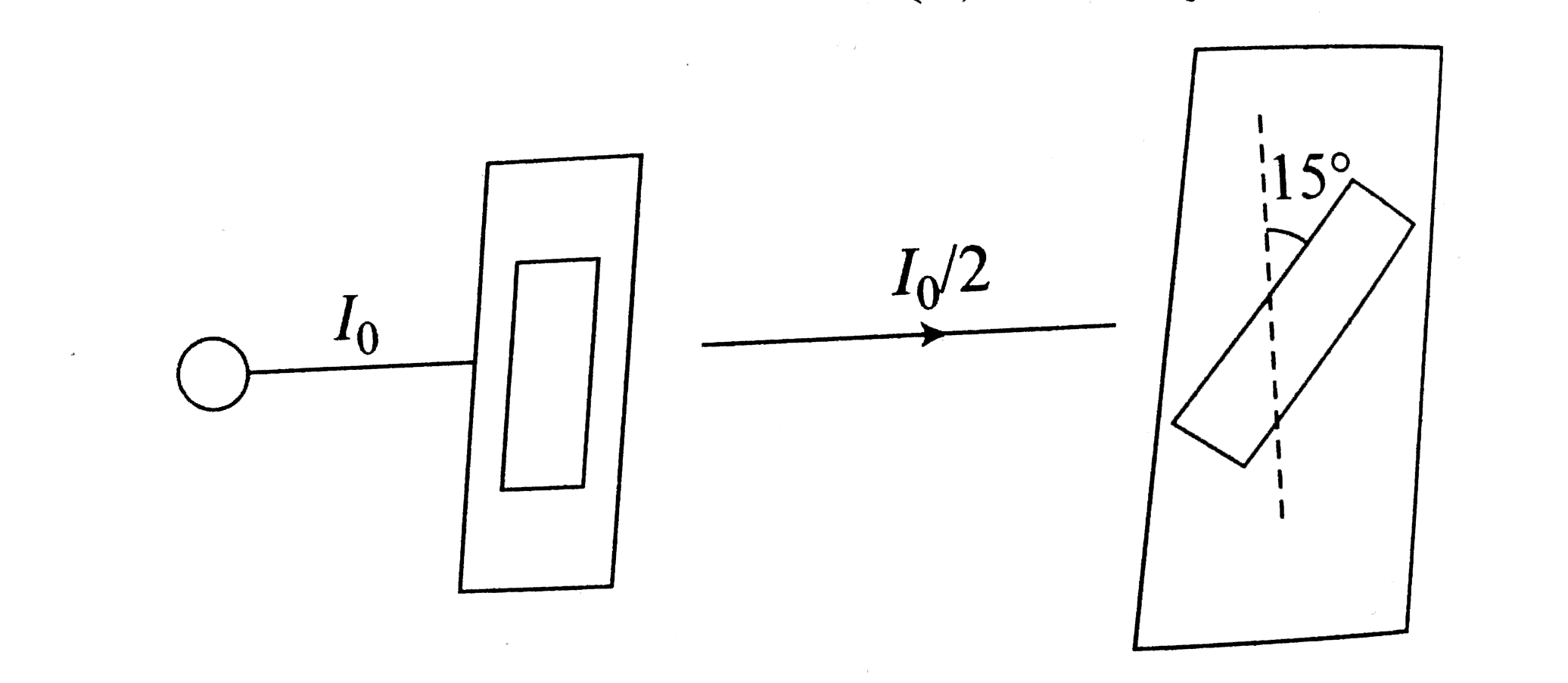A plane polarized light with intensity I0 is incident on a polaroid with Electric Field vector making an angle of 60∘ with transmission axis of polaroid. The intensity of the resulting light will be
To solve the problem of finding the intensity of the resulting light after passing through a polaroid, we can follow these steps:
1. Understand the Given Information:
- We have a plane polarized light with an initial intensity I0.
- The electric field vector of the light makes an angle of 60∘ with the transmission axis of the polaroid.
2. Apply Malus's Law:
- Malus's Law states that when polarized light passes through a polarizer, the intensity I of the transmitted light is given by:
I=I0cos2θ
- Here, θ is the angle between the electric field vector of the incident light and the transmission axis of the polaroid.
3. Substitute the Values:
- In this case, θ=60∘.
- Therefore, we can substitute this angle into Malus's Law:
I=I0cos2(60∘)
4. Calculate cos(60∘):
- We know that cos(60∘)=12.
- Now, substitute this value into the equation:
I=I0(12)2
5. Simplify the Expression:
- Simplifying the equation gives:
I=I0⋅14
- Thus, the intensity of the resulting light is:
I=I04
Final Answer:
The intensity of the resulting light after passing through the polaroid is I04.
---
- We have a plane polarized light with an initial intensity I0.
- The electric field vector of the light makes an angle of 60∘ with the transmission axis of the polaroid.
- Malus's Law states that when polarized light passes through a polarizer, the intensity I of the transmitted light is given by:
I=I0cos2θ
- Here, θ is the angle between the electric field vector of the incident light and the transmission axis of the polaroid.
- In this case, θ=60∘.
- Therefore, we can substitute this angle into Malus's Law:
I=I0cos2(60∘)
- We know that cos(60∘)=12.
- Now, substitute this value into the equation:
I=I0(12)2
- Simplifying the equation gives:
I=I0⋅14
- Thus, the intensity of the resulting light is:
I=I04
The intensity of the resulting light after passing through the polaroid is I04.
Topper's Solved these Questions
- WAVE OPTICSBOOK - AAKASH INSTITUTE ENGLISHCHAPTER - WAVE OPTICSEXERCISE - Try yourself
24 Videos
- WAVE OPTICSBOOK - AAKASH INSTITUTE ENGLISHCHAPTER - WAVE OPTICSEXERCISE - Assignment (Section-A (objective type question(one option is correct)))
55 Videos
- UNITS AND MEASUREMENTSBOOK - AAKASH INSTITUTE ENGLISHCHAPTER - UNITS AND MEASUREMENTSEXERCISE - ASSIGNMENT (SECTION - D)
15 Videos
- WAVESBOOK - AAKASH INSTITUTE ENGLISHCHAPTER - WAVESEXERCISE - ASSIGNMENT ( SECTION-D ( Assertion - Reason Type Questions ))
12 Videos
Similar Questions
A polarized light of intensity I0 is passed through another polarizer whose pass axis makes an angle of 60∘ with the pass axis of the former, What is the intensity of emergent polarized light from second polarizer?
View SolutionAn unpolarised beam of intensity I0 is incident on a pair of nicols making an angle of 60∘ with each other. The intensity of light emerging from the pair is
View SolutionA polarised light intensity I0 is passed through another polariser whose pass axis makes an angle of 60∘ with the pass axis of the former, What is the intensity of emergent polarised light from second polarised?
View SolutionWhen an unpolarized light of intensity I0 is incident on a polarizing sheet, the intensity of the light which dows not get transmitted is
View Solution(a) Distinguish between unpolarized light and linearly polarized light. How does one get linearly polarised light with the help of a plaroid ?
(b) A narrow beam of unpolarised light of intensity I0 is incident on a polaroid P1. The light transmitted by it is then incident on a second polaroid P2 with its pass axis making angle of 60∘ relative to the pass axis of P1. Find the intensity of the light transmitted by P2.
View SolutionAn unpolarized light with intensity 2I0 is passed through a polaroid. The resultant intensity of the transmitted light will be
View SolutionA plane polarized light is incident normally on a tourmaline plate. Its E vector make an angle of 60∘ with the optic axis of the plate. Find the percentage difference between initial and final intensities
View SolutionUnpolarized light with intensity I0 is incident on combination of two polarizers as shown . The intensity of the light after passage through both the polaroids will be.

View Solution_2019_CBT8_E01_023_Q01.png)
Unpolarised light beam of intensity I0 is incident on polaroid P1. The three polaroids are arranged in such a way that transmission axis of P1 and P3 are perpendicular to each other. Angle between the trasmission axis of P2 and P3 60∘. The intensity of the beam coming out from P3 will be:
View SolutionLight is incident on a polarizer with intensity I0. A second prism called analyzer is kept at a angle of 15∘, from the first polarizer then the intensity of final emergent light will be

View Solution
